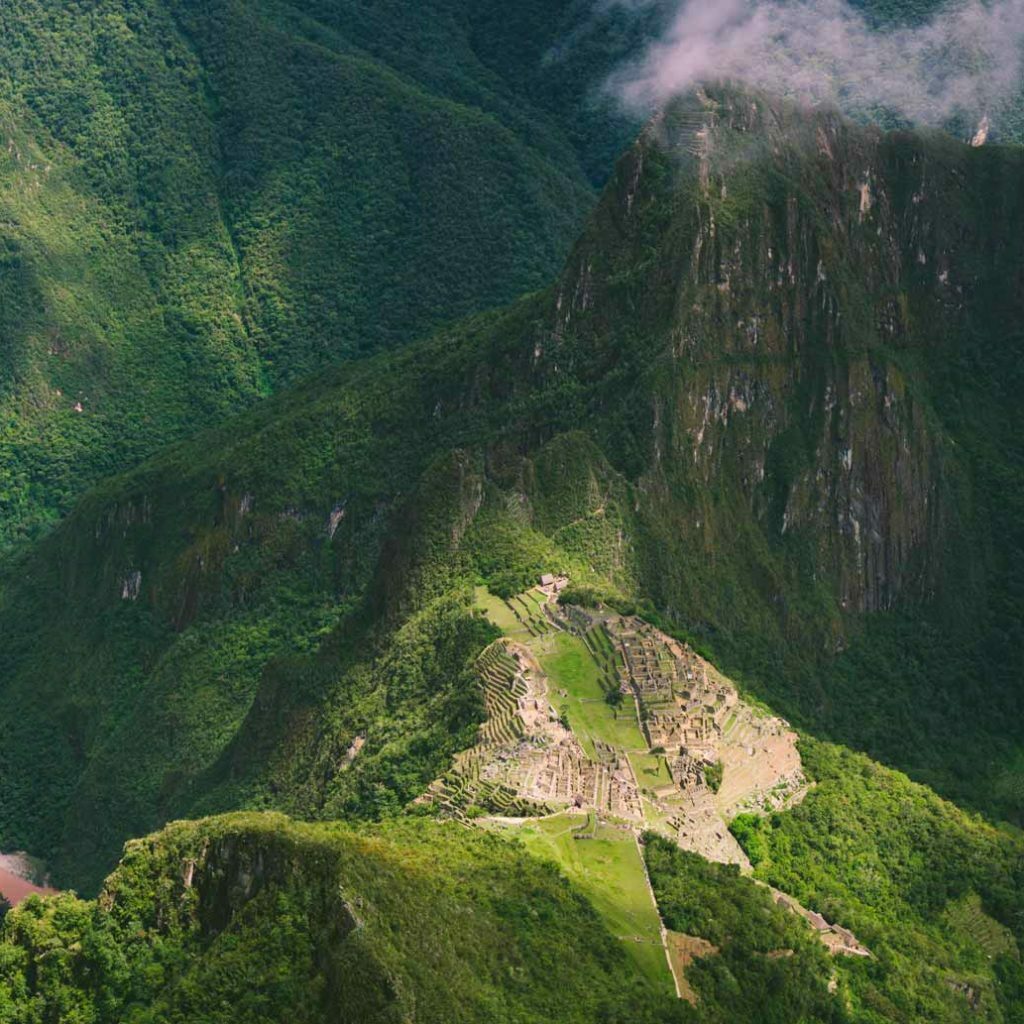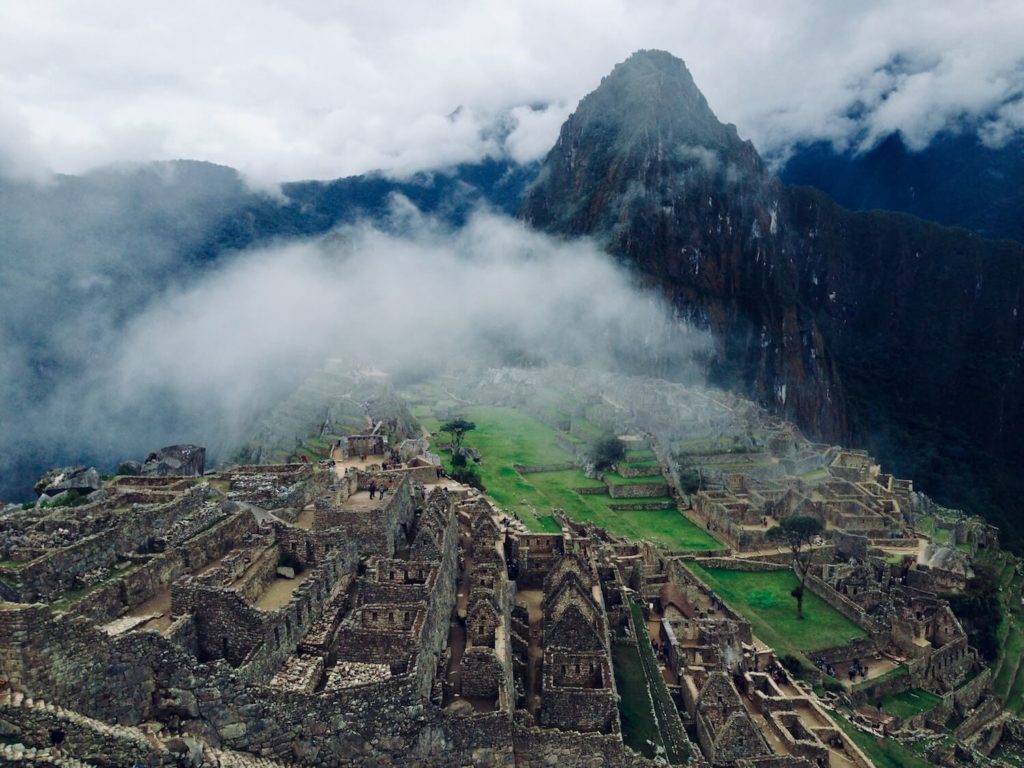Every day thousands of people venture up to the citadel of Machu Picchu. Of those thousands, only a few brave ones choose to prove their aptitude by climbing one of the two peaks surrounding the ruins. Without a doubt, these hikes are extraordinarily beautiful and are typically done early in the morning when the fog clears, revealing the majesty of the Inca landmark. The most popular is the Huayna Picchu. But since only 400 climbers are allowed on Huayna Picchu on any given day, many are left out. Fortunately for those adventurers, there is an even higher and equally beautiful climb: Cerro Machu Picchu or “Machu Picchu Mountain”.
Overview
- Elevation: 10,111 ft (3,082 m)
- Elevation Gain: 2,139 ft (652 m)
- Climate: Tropical, cloud forest
- Terrain: Mountainous.
- Difficulty: Moderate
- Duration: ~3 hours round trip
- Length: 3.1 mi (5 km) round trip
- Entrance Times: 7am, 10am
- Recommended Clothing: Layers, long pants (to protect against biting flies), hat, hiking boots, sunglasses
- Trailhead: 15 min walk from the entrance through the Machu Picchu sanctuary.
- Known For: Best view of Machu Picchu, less crowded.

The mountain of Machu Picchu
Any trip to the citadel of Machu Picchu is not complete without climbing one of the neighboring peaks, and getting another perspective of the full extent of the iconic Inca ruins. The most popular option for this is to climb the Huayna Picchu (Young Mountain in Quechua), that sugar loaf-shaped peak that is seen presiding over the site in classic photos of Machu Picchu.
As I was not among the lucky 400 who arrived in time to buy one of the limited tickets for the narrow trail, I was offered a ticket to Machu Picchu Mountain (Old Mountain), which is on the opposite side of the ruins, and is much, much higher.
Unlike Huayna Picchu, which is very popular, fewer visitors take on the challenge of climbing Old Mountain. This means that you will often have much of the mountain to yourself.

Climbing the Machu Picchu mountain
Although the time restrictions are not as strict (the door opens from 7 to 11 a.m.), it is still a good idea to go early to avoid the midday heat and have enough time to enjoy the trip and the views. I left as soon as the door opened at 7 a.m., with the ruins of Machu Picchu still enveloped in thick clouds. After checking in at the director’s cabin, I began my ascent in the fog, climbing the thousands of stone steps.
After half an hour or so, I reached a wider part of the trail where there was a clearing in the trees. I stopped to breathe and then noticed that the clouds over the opposite mountains were quickly evaporating with the rising sun. This was it! This was my “moment in life” experience of seeing Machu Picchu appear through the fog!
In a matter of minutes, the Caretaker’s Cabin was the first building to emerge in a circle of clouds. Then, gradually, the whole site was revealed to the small crowd of hikers that had gathered at this perfect lookout point. The cameras now well-populated, we began to stride again in anticipation of better views to reach higher ground.
What I didn’t fully understand at the time was how high I was going to climb. The stone steps along the way continued, and as the road turned with a new view over the ruins, the citadel seemed to get smaller and smaller.
My legs hurt. It was getting hotter and wetter in this semi-selvaceous climate. I was distracted by the sight of exotic birds that were flying through the vegetation along the way. I stopped and sat down many times. I almost gave up when I saw another stretch of steeper and steeper stone steps in front of me. But somehow I made it to the top. And I’m very glad I did.
The view over Machu Picchu from the mountain that bears his name is unrivalled. Huayna Picchu is reduced to a mere hump from this height. The ruins look like small gray Lego buildings, and the brightly dressed tourists look like multicolored ants.
The view from the mountain of Machu Picchu also offers you the opportunity to put into perspective the amazing location of the Inca city of Machu Picchu. The silky Urubamba River crashes at the foot of the mountain to which the site extends, turning it into an almost island in the middle of the peaks.
The mountains that drip with the jungle undulate as far as the eye can see. You can even see where the Inca Trail enters the slopes of the surrounding hills, and you can see the banks of the Aguas Calientes River where you could have spent the night, and the Santa Teresa hydroelectric plant.
I sat for a while at the top drinking in the scenery, with some other equally mesmerized hikers and some tropical butterflies fluttering about in company.
And just like that, an unexpected climb up the mountain became the highlight of my trip to the legendary Machu Picchu, if not of all my travels in South America, so far.
Tips and Advice
These are the advices we give from Machu-Picchu.org on how to climb the mountain of Machu Picchu:
- When you buy your ticket to Machu Picchu (well in advance, of course), ask for the combined ticket with the entrance to the mountain of Machu Picchu (Montana).
- Leave early. Try to arrive at the door of the base of the mountain of Machu Picchu at the time it opens at 7 in the morning. The last entrance to the mountain is at 11 a.m. The climb takes a good hour and a half to two hours (I took 2 and a half hours while taking it easy) and then at least another hour to descend again. When you enter through the main gates of the site, don’t be tempted to start exploring the ruins; follow the signs to Puerta del Sol and then turn towards Cerro Machu Picchu.
- You should be well acclimated to the altitude before attempting this hike – the air is thin and you will notice the difference, no matter how fit you are!
- Bring plenty of water, at least 2 liters each, plus some snacks since there are no facilities for buying refreshments after entering the site. Be respectful and discreet in the place you choose to stop to eat, and never leave any kind of garbage.
- Wear supportive walking shoes and cool, comfortable clothing.
- Wear sunscreen, a hat and sunglasses – the sun gets intense at this point.
- Remember your fully charged camera and spare SD cards!
- Otherwise, take as little as possible!
 English
English Spanish
Spanish Portuguese
Portuguese



How long does it take to reach the top of the mountain?
Depending on your physical condition it may vary how long it takes to reach the top. On average it takes from 1 hour to 2 hours to get there.